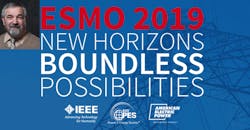ESMO 2019: Q&A With Dr. George Gela of Berkshire Electric Transmission Consulting
To protect electrical workers from arc flash hazards, researchers have performed tests, and manufacturers have invented new types of specialized protective clothing, equipment and devices. Up to this point, the majority of the research has focused on arcs in short gaps on AC systems, yet workers can also be exposed to arc flashes on DC systems as well.
To learn about the latest research and technologies surrounding arc flash, register for ESMO 2019 and attend the session titled, "Arc Flash Hazards and New IEEE and IEC Standards." Experts on this panel will review the new IEEE 1584 standard “IEEE Guide for Performing Arc Flash Hazard Calculations,” test procedures and performance requirements for protective clothing, new international IEC standards and limits of applicability of the available standards. The panel will also discuss characteristics of long arcs on HVAC lines.
Dr. George Gela, an internationally recognized electric utility expert with a doctoral degree in electrical engineering and an extensive background in research, testing and teaching, will lead the panel. The following Q&A explores the topic of arc flash and what to expect during his session at ESMO 2019. To see a full list of panelists, click here.
Q: Discuss how you got involved with ESMO.
A: I attended ESMO for the first time in 1987 in Albuquerque, New Mexico.
Q: What is your favorite part of the event?
A: The outdoor demonstrations and exhibits.
Q: Talk about what's in store for attendees for this year's conference as well as the benefits of attending.
A: ESMO is a unique type of meeting, which has served as the catalyst for other conferences and exhibits including ICOLiM in Europe and CITTES in South America.
The event includes presentations of new concepts, live working procedures and tools and equipment. It also features actual live demonstrations of tools, equipment, procedures and implementation of the theory behind safety live working. Both the presentations and the live outdoor demonstrations appeal to all involved in live work: the young and the seasoned craft workers who perform live work; the safety personnel, management, engineering staff who develop safe working procedures and equipment; the manufacturers of tools and equipment; the consulting community; the interested researchers and academic community and public bystanders.
Q: Your technical session at ESMO 2019 will focus on arc flash hazards. How did you select this topic, and what can attendees expect to learn?
A: This is a very timely topic that deals with the protection of workers from serious incidents. There is a lot of confusion within the industry regarding exposure levels and selection of protective equipment. This session aims to help clarify many issues, introduce the audience to new research and test results and help users select appropriate protective apparel.
Q: Your panelists will also give an overview of the changes to IEEE and IEC standards. Can you give a brief overview of these new standards and how they affect the industry?
A: The most recent IEEE standard 1584 is a complete update of the previous edition and clarifies the nature of various arcs, calculation of anticipated exposure levels, and selection of protective apparel. The group of IEC standards brings in worldwide experience and covers additional areas that are not yet addressed in the IEEE documents.
Q: What is new with personal protective equipment for workers, and how does it help them to protect against arc flash?
A: There are new materials for protective clothing and new guidelines for estimating the expected exposure level both from AC and DC arcs, as well as new guideline related to protective levels of layered clothing. The audience will have the opportunity to ask detailed questions of the experts on the panel during the Q&A period at the end of the session.
Q: Discuss the role of arc flash testing and how it has improved the safety of line work over the past few years.
A: High-current arcs are very difficult to model theoretically. Also, work-site conditions are quite complicated and vary significantly from case to case. Therefore, standardized test procedures needed to be developed to simulate expected worst-case conditions and to provide the basis for comparison of performance parameters of various protective clothing and work conditions. A very significant effort at high cost has been devoted to understanding the phenomenon and consequences of a high-current arc. Many tests were performed and specialized protective clothing, equipment and devices are now available to help ensure safety in live work.
Q: How did you get interested in the power industry?
A: While most of my classmates in 1970s were attracted to computer science, biomedical and communications engineering, I opted to study power systems and high voltage, mainly as a result of the experience of the 1965 Northeast blackout. My Masters (M.A. Sc., 1975) and Doctoral (Ph.D., 1980) research and theses focused on power systems and high voltage. I have never regretted this choice. I spent more than three decades conducting research and full-scale testing in those areas, and now I have the distinct honor to help educate and mold new power engineers at Rensselaer Polytechnic Institute (RPI) in Troy, New York.
Q: Any other comments?
A: The session will cover testing, practical and theoretical topics. Be there!
